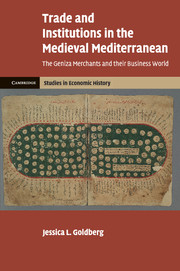Crossref Citations
This Book has been
cited by the following publications. This list is generated based on data provided by Crossref.
Goldberg, Jessica L.
2011.
On reading Goitein'sA Mediterranean Society:a view from economic history.
Mediterranean Historical Review,
Vol. 26,
Issue. 2,
p.
171.
Balleisen, Edward J.
Clarke, Sally
Karpoff, Jonathan M.
Macey, Jonathan
Harris, Ron
and
Chapin, Christy Ford
2013.
Corporate Reputation Roundtable.
Business History Review,
Vol. 87,
Issue. 4,
p.
627.
Leonard1, Adrian
2013.
Questioning Credible Commitment.
p.
48.
Frantz, Christopher
Purvis, Martin K.
and
Nowostawski, Mariusz
2014.
Agent-Based Modeling of Information Transmission in Early Historic Trading.
Social Science Computer Review,
Vol. 32,
Issue. 3,
p.
393.
Roth, Pinchas
2014.
Legal Strategy and Legal Culture in Medieval Jewish Courts of Southern France.
AJS Review,
Vol. 38,
Issue. 2,
p.
375.
Frantz, Christopher
Purvis, Martin K.
Nowostawski, Mariusz
and
Savarimuthu, Bastin Tony Roy
2014.
Analysing the Dynamics of Norm Evolution Using Interval Type-2 Fuzzy Sets.
p.
230.
Epstein, Steven A.
2014.
A Companion to Mediterranean History.
p.
345.
Abulafia, David
2014.
A Companion to Mediterranean History.
p.
137.
Christ, Georg
2014.
Everything is on the Move.
p.
27.
Grafe, Regina
2014.
On the spatial nature of institutions and the institutional nature of personal networks in the Spanish Atlantic.
Culture & History Digital Journal,
Vol. 3,
Issue. 1,
p.
e006.
Astren, Fred
2014.
A Companion to Mediterranean History.
p.
392.
Frantz, Christopher
Purvis, Martin K.
Nowostawski, Mariusz
and
Savarimuthu, Bastin Tony Roy
2015.
Multi-Agent-Based Simulation XV.
Vol. 9002,
Issue. ,
p.
180.
Bruce, Travis
2015.
Commercial conflict resolution across the religious divide in the thirteenth-century Mediterranean.
Mediterranean Historical Review,
Vol. 30,
Issue. 1,
p.
19.
Bramoullé, David
2015.
Héritages arabo-islamiques dans l'Europe méditerranéenne.
p.
269.
Pecci, Alessandra
Gabrieli, Ruth Smadar
Inserra, Fernanda
Cau, Miguel Angel
and
Waksman, Sylvie Yona
2015.
Preliminary results of the organic residue analysis of 13th century cooking wares from a household in Frankish Paphos (Cyprus).
STAR: Science & Technology of Archaeological Research,
Vol. 1,
Issue. 2,
p.
99.
Frantz, Christopher K.
Purvis, Martin K.
Savarimuthu, Bastin Tony Roy
and
Nowostawski, Mariusz
2015.
Coordination, Organizations, Institutions, and Norms in Agent Systems X.
Vol. 9372,
Issue. ,
p.
53.
Bresc, Henri
2015.
Le marché et la grâce : points de vue d’un médiéviste.
Mélanges de l'École française de Rome. Italie et Méditerranée,
Saletti, Beatrice
2015.
L’affare della Tomba di David (Gerusalemme, XV secolo): I frati minori e i loro protettori europei tra sequestri, ritorsioni ed embargo.
I Tatti Studies in the Italian Renaissance,
Vol. 18,
Issue. 1,
p.
193.
Frantz, Christopher
Purvis, Martin K.
Purvis, Maryam A.
Nowostawski, Mariusz
and
Lewis, Nathan D.
2015.
Frontiers of Higher Order Fuzzy Sets.
p.
87.
Lamoreaux, Naomi
2015.
The Future of Economic History Must Be Interdisciplinary.
The Journal of Economic History,
Vol. 75,
Issue. 4,
p.
1251.



